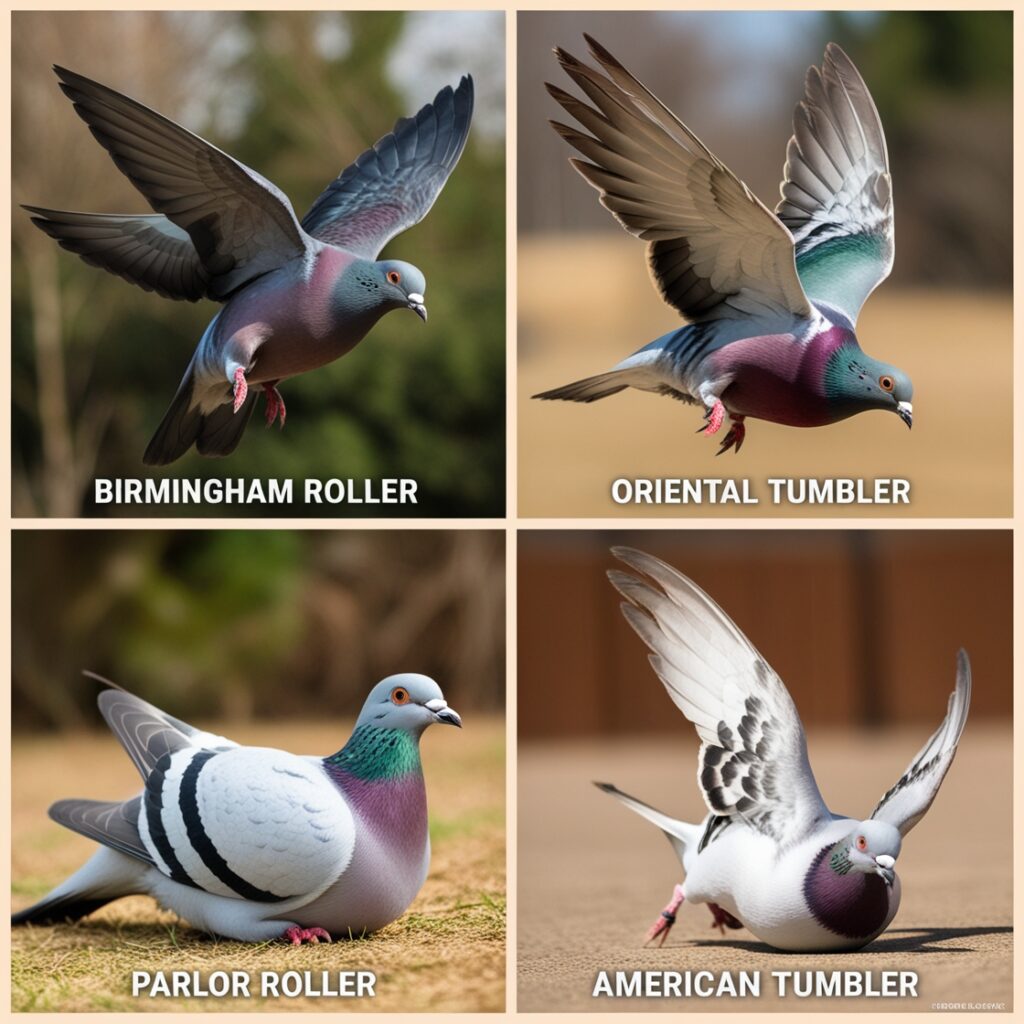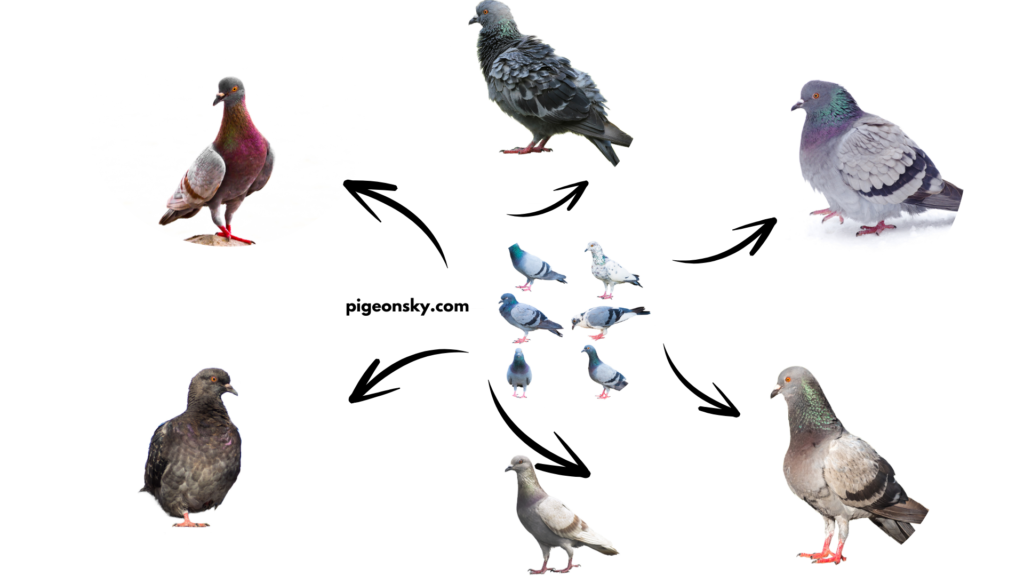Rollers and Tumblers Pigeons
Types and Characteristics of Rollers and Tumblers Pigeons
Types of Rollers and Tumblers

-
Rollers and Tumblers: The Acrobatic Pigeons
Roller and Tumbler pigeons are renowned for their captivating aerial displays and acrobatic skills, making them favorites among pigeon enthusiasts. While both breeds are celebrated for their unique flight maneuvers, they differ in their specific abilities and appearances.
Roller Pigeons
Rollers are famous for their extraordinary acrobatic abilities, particularly their tendency to perform backward somersaults while flying. This mesmerizing rolling motion can occur both in the air (flying rollers) and on the ground (parlor rollers). Breeders have dedicated themselves to maintaining these traits, leading to the development of two main types of Rollers:
- Birmingham Rollers: Perhaps the most recognized among Roller pigeons, Birmingham Rollers are small to medium-sized birds characterized by their short, compact bodies. They are especially noted for their rapid and controlled backward somersaults during flight. These birds can perform multiple rolls consecutively while maintaining flight, captivating spectators with their acrobatic prowess.
- Parlor Rollers: Unlike Birmingham Rollers, Parlor Rollers are specifically bred for their ability to roll on the ground rather than in the air. These birds are often showcased in competitions, where they perform impressive rolls over considerable distances without flying. Their unique skill set makes them a fascinating addition to the Roller pigeon community.
Tumbler Pigeons
Tumblers are equally intriguing birds known for their distinctive tumbling maneuvers. Unlike the backward somersaults of Rollers, Tumblers typically execute forward or downward tumbles, often performing these stunts in flocks. Their tumbling motions are brief yet controlled, creating an exciting spectacle. Major types of Tumblers include:
- Oriental Tumblers: Known for their elegant appearance and slightly longer beaks, Oriental Tumblers are smaller birds that execute controlled tumbles during flight. Bred primarily in the Middle East and Asia, these pigeons are often used in competitive flying due to their agility and grace.
- American Tumblers: Bred mainly for their aesthetic appeal and competitive abilities, American Tumblers are medium-sized pigeons with short beaks. They are recognized for their swift and agile tumbles during flight, making them popular in shows and exhibitions.
- Budapest Tumblers: Originating from Hungary, Budapest Tumblers are slender birds with a distinctive tall posture and prominent eyes. They are capable of performing impressive mid-air tumbles, sometimes completing multiple rotations in a single maneuver, showcasing their exceptional aerial capabilities.
Characteristics of Rollers and Tumblers
Despite their differences, Rollers and Tumblers share several common characteristics that make them beloved among pigeon breeders:

-
Birmingham Rollers: The Acrobats of the Sky
Birmingham Rollers are a captivating breed of pigeons renowned for their extraordinary aerial acrobatics, particularly their ability to perform backward somersaults mid-air. These birds are celebrated not only for their striking appearance but also for their agility and unique behavioral characteristics. Originating from Birmingham, England, they have gained worldwide recognition due to their remarkable rolling flights. This article delves into the history, breeding, training, flight characteristics, and cultural significance of Birmingham Rollers.
History and Origins
The Birmingham Roller pigeon traces its roots back to the late 19th century in Birmingham, England. The breed was developed by working-class pigeon enthusiasts who sought to create a bird capable of performing remarkable aerial acrobatics. Through generations of selective breeding, these enthusiasts focused on cultivating pigeons that could execute rapid, backward somersaults during flight while maintaining altitude.
The breed’s distinctive rolling ability can be attributed to the careful selection of parent stock that exhibited exceptional agility and balance. Over time, the Birmingham Roller became a beloved part of local culture, with enthusiasts hosting competitions to showcase the birds’ incredible skills. As the breed gained popularity, it spread beyond England, becoming a favorite among pigeon fanciers around the globe.
Physical Characteristics
Birmingham Rollers typically exhibit a compact, muscular build with a broad chest and a strong, sturdy frame. They possess smooth, sleek feathers that come in a wide variety of colors and patterns, ranging from pure whites and blacks to striking mixes of blues, grays, and browns.
The breed’s beak is generally short and well-proportioned, allowing for efficient feeding and drinking. Their bright, expressive eyes contribute to their charm, and the birds are known for their spirited personalities. This combination of physical beauty and acrobatic talent makes Birmingham Rollers highly sought after by breeders and enthusiasts alike.
Acrobatic Abilities
The hallmark of Birmingham Rollers is their incredible aerial acrobatics. These birds can perform rapid, controlled backward somersaults, often referred to as “rolling.” The rolling motion is not only visually stunning but also a testament to the birds’ exceptional balance, strength, and agility.
Breeders have meticulously cultivated these abilities through selective breeding, focusing on enhancing traits that contribute to the birds’ aerial performances. The result is a breed that can execute multiple rolls in succession, often while maintaining steady flight, creating a mesmerizing spectacle for onlookers.
Training and Performance
To maintain and improve their aerial performances, Birmingham Rollers require regular training. Breeders often train them to fly in specific patterns, emphasizing the development of their acrobatic tendencies through consistent exercise and conditioning.
Training typically begins when the birds are young, as they learn to fly and develop their skills. Many breeders utilize a combination of encouragement, rewards, and structured training sessions to help the birds hone their abilities. Over time, the birds become adept at performing their remarkable rolling stunts, and regular practice ensures that they remain agile and responsive.
Competitions play a significant role in the Birmingham Roller community, where fanciers gather to showcase their birds’ skills. These events often feature judging criteria that include the number of rolls performed, the height of the flight, and overall control during acrobatics. Such competitions foster camaraderie among enthusiasts and promote the ongoing refinement of the breed.
Social Behavior
Birmingham Rollers are social animals that thrive in flocks. Like most pigeon species, they enjoy the company of their peers and prefer environments where they can fly and interact with other pigeons. This social nature contributes to their overall well-being, as they develop strong bonds with both their fellow birds and their human caretakers.
In captivity, providing ample space for these pigeons to fly and explore is essential. A spacious aviary or loft equipped with perches and safe areas for exercise encourages natural behaviors, allowing the birds to flourish both physically and socially.
Cultural Significance
Birmingham Rollers hold a special place in the hearts of pigeon fanciers and enthusiasts worldwide. Their unique acrobatic abilities have made them a symbol of skill and dedication in the world of aviculture. The breed’s popularity has led to a rich culture surrounding its care and breeding, with clubs and organizations dedicated to preserving and promoting Birmingham Rollers.
Competitions and exhibitions celebrate the artistry of breeding and the exceptional talent of these birds, fostering a sense of community among pigeon enthusiasts. Additionally, the Birmingham Roller serves as an inspiration for new generations of bird lovers, encouraging interest in aviculture and the appreciation of these remarkable creatures.

Birmingham Rollers: The Acrobats of the Sky
Birmingham Rollers are a captivating breed of pigeons celebrated for their extraordinary aerial acrobatics, particularly their ability to perform rapid backward somersaults while in flight. These birds are cherished not only for their remarkable flying skills but also for their striking appearance and charming personalities. Originating from Birmingham, England, they have gained worldwide recognition due to their unique rolling flights. This article explores the history, flight characteristics, breeding practices, and cultural significance of Birmingham Rollers.
History and Origins
Birmingham Rollers are closely associated with a dedicated subculture of pigeon fanciers in the United Kingdom, who take pride in breeding birds with exceptional performance abilities. The exact lineage of the Birmingham Roller remains somewhat unclear, but it is believed that the breed evolved from various types of rolling pigeons imported to the British Isles from Europe and the Middle East. Over time, these imported pigeons were selectively bred to enhance their rolling ability, leading to the development of the modern Birmingham Roller.
By the early 20th century, Birmingham Rollers had spread beyond England and were introduced to other parts of the world, including the United States, Canada, and various European countries. The breed has since become a global phenomenon, with clubs, competitions, and a devoted following of breeders dedicated to preserving and enhancing its unique characteristics.
Flight Characteristics
The defining feature of Birmingham Rollers is their ability to perform rapid backward somersaults while flying, often referred to as “rolling.” These acrobatic feats occur mid-flight and can involve multiple consecutive rolls, creating a dazzling display that has captivated observers for generations.
What sets Birmingham Rollers apart is their exceptional control during these rolls. Unlike some other rolling pigeon breeds that may lose altitude or become disoriented during the rolling process, Birmingham Rollers maintain a remarkable level of stability. They can execute multiple rolls without significantly dropping in height or losing their position within a flock. This ability to control their movements allows them to remain airborne longer, performing impressive aerial displays.
The Science Behind the Roll
The rolling behavior of Birmingham Rollers is a fascinating interplay of genetics and training. Over generations, breeders have selectively chosen birds with strong rolling instincts to ensure the trait is passed on to their offspring. The mechanics behind the roll involve a complex coordination of the bird’s muscles, balance, and nervous system.
It is believed that the rolling motion is closely linked to the bird’s vestibular system, which helps maintain balance and spatial orientation. When a Birmingham Roller performs its characteristic somersaults, it triggers a reflexive response in its muscles and nervous system, allowing the bird to recover quickly and resume normal flight after completing the roll. This reflex has likely been honed through selective breeding, enabling the birds to execute rolls without becoming disoriented.
Interestingly, not all Birmingham Rollers roll with the same frequency or intensity. Some birds may perform short, rapid rolls, while others may execute longer, more dramatic spins. Breeders often assess the quality of a bird’s roll in terms of its “depth,” with deeper rolls being more impressive but also riskier, as they can lead to a loss of control or a rapid descent. Experienced breeders strive to achieve a balance between depth and control, ensuring that their birds can perform impressive rolls while maintaining their position in the air.
Breeding Birmingham Rollers
Breeding Birmingham Rollers is both an art and a science that requires careful selection of birds with desirable traits, such as strong rolling ability, excellent control during flight, and overall health and vitality. Breeders typically pair birds that exhibit exceptional rolling behavior, hoping to produce offspring that inherit these desirable qualities.
One of the challenges in breeding Birmingham Rollers is maintaining the delicate balance between performance and physical health. Birds that roll too frequently or too deeply can be at risk of injury, as the rapid spinning motion may strain their muscles and joints. Additionally, birds that lack control during their rolls are prone to crashing into obstacles or falling to the ground. Consequently, breeders must closely monitor their birds’ performance and make adjustments to their breeding programs as necessary.
Cultural Significance
Birmingham Rollers hold a special place in the hearts of pigeon fanciers and enthusiasts worldwide. Their unique acrobatic abilities have made them a symbol of skill and dedication within the aviculture community. The breed’s popularity has fostered a rich culture surrounding its care and breeding, with clubs and organizations committed to preserving and promoting Birmingham Rollers.
Competitions and exhibitions play a significant role in the Birmingham Roller community, where fanciers gather to showcase their birds’ skills. These events often feature judging criteria that include the number of rolls performed, the height of the flight, and overall control during acrobatics. Such competitions foster camaraderie among enthusiasts and promote the ongoing refinement of the breed.
Conclusion
Birmingham Rollers stand out as one of the most captivating pigeon breeds, renowned for their extraordinary aerial acrobatics and charming personalities. Their history, marked by the dedication of passionate breeders, has led to the development of a bird that not only performs impressive stunts but also brings joy to enthusiasts around the world.
As the breed continues to thrive and evolve, Birmingham Rollers remain a testament to the beauty of aviculture and the enduring bond between humans and their feathered companions. Whether in competition or simply soaring through the skies, these acrobatic pigeons continue to capture the imagination and admiration of all who witness their incredible performances.


